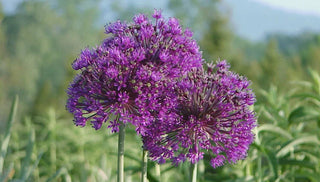Onions, shallots and garlic are members of the allium family that belong in the vegetable garden. But there are many ornamental alliums that deserve a hearty welcome in your perennial gardens.
Alliums are plants of exquisite beauty in both flower and leaf, with tough constitutions. These easy-to-grow bulbs come in a broad palette of colors, heights, bloom times and flower forms. They make excellent cut flowers for fresh or dried bouquets. Even crowded gardens can accommodate a few alliums because they don't take up much space. What's more, alliums are relatively resistant to deer, voles, chipmunks, and rabbits
Ordinary Onions They're Not
There are more than 700 different types of alliums in the world. It wasn't until the late 1800s that this vast group of plants started to intrigue plant lovers. Russian botanists began collecting some of the spectacular alliums from Central Asia and introducing them to avid horticulturists through the Imperial Botanical Garden in St. Petersburg. Of course, it didn't take long for the consummate plant hunters, the British, to get wind of this "new" family of garden-worthy plants. Their expeditions yielded many more interesting alliums varieties.
 A display at the Chelsea Flower Show shows the diversity of the allium genus.
A display at the Chelsea Flower Show shows the diversity of the allium genus.Hardy, Easy-Care, Deer- and Rodent-Resistant
Ornamental alliums are hardy to zone 4 and they have very undemanding cultural requirements. They will grow in most any soil, as long as it is well-drained. Alliums adore sunlight and will perform best when they can bask in it all day long. Since most of them multiply naturally, they can be left untouched in the same area for years.
Alliums are drought-tolerant plants that actually prefer to be grown on the dry side. There are no serious diseases or insect pests that bother them. And you won't ever have to worry about rodents or deer, since they seem to have no appreciation for the taste of onions — ornamental or otherwise.
Just remember, there's only one time of year you can plant alliums: in the fall. Daffodils, tulips and crocuses are easy to find at most garden centers, but alliums are not as readily available. To make sure you have the bulbs in hand when it's time to plant, the best thing to do is order them by mail. That way, they'll show up at your door at proper planting time, and there's no chance you'll have to live another year without these beautiful, long-lasting, bee-friendly flowers in your garden. Some ornamental alliums grow more like chives and what you plant is a clump of roots rather than bulbs. This type of allium is usually sold as a potted plant, and may be more available in spring than fall.
Favorite Alliums
There are dozens of varieties in cultivation; here are some of the best:
 The Purple Sensation allium bridges the gap between spring and early summer-flowering perennials.
The Purple Sensation allium bridges the gap between spring and early summer-flowering perennials.Purple Sensation: the 2" to 4" diameter purple globes bloom in early June, right after the late tulips. Purple Sensation's sturdy stems rise 24" to 30" high, so the flowers appear to float above the foliage of newly emerging perennials.
Globemaster and Gladiator: The tallest and most architectural alliums have huge, globe-shaped flowerheads on 3- to 4-foot stems. Bloom time is early to mid-June. A group of deep-purple Globemaster or Gladiator alliums is a real eye-catcher, especially when planted with white or pink peonies, delphiniums or tall bearded iris. The white-flowering Mount Everest is a bit shorter and looks sharp in front of shrubs with deep-green or burgundy foliage or rising out of a groundcover of periwinkle (Vinca minor).
 The Ozawa allium is among the last perennials to flower. Shown here with asters, its pink flowers are still forming atop a grassy clump of foliage.
The Ozawa allium is among the last perennials to flower. Shown here with asters, its pink flowers are still forming atop a grassy clump of foliage.Ozawa allium (Allium thunbergii 'Ozawa'): A tidy, clump-forming plant that grows 18" to 20" high. Among the last of the perennials to bloom, its flowers often don't open until late September or October. Bees love it. Another late-bloomer that flowers in autumn. Its pink flowers pair well with coreopsis, gaillardia, solidago and other fall flowers.
Corkscrew allium: Drought-tolerant corkscrew allium (Allium senescens ssp. montanum var. glaucum) makes a good edging plant in the dry soil at the top of my stone retaining wall. Its blue-green leaves twist like loose corkscrews. Bloom time is late summer.
 Schubert alliums at the Chelsea Flower Show in England.
Schubert alliums at the Chelsea Flower Show in England.Schubert allium (Allium schubertii): Quite dramatic, though only 8" tall . Its foot-wide umbels look like an exploding pink fireworks display. Sure to elicit comments from garden visitors. Seed heads add interest for a month or more after blooms fade.
 The drumstick allium is a bit floppy, so plant it among other perennials that can provide support.
The drumstick allium is a bit floppy, so plant it among other perennials that can provide support.Drumstick allium (Allium sphaerocephalon): Blooms in early July, a couple weeks after Purple Sensation. Not as erect and orderly as Purple Sensation, but in the right place (where casual is OK), the two-toned, burgundy-green heads are fantastic. Great with ornamental grasses.
 This yellow allium (Allium flavum) is a good choice for rock gardens
This yellow allium (Allium flavum) is a good choice for rock gardensYellow allium (Allium flavum): A midsummer-blooming favorite that is well-suited to rock gardens. Over a 10-day period, the cluster of florets slowly emerges and becomes an exuberant display of color. Related species available in yellow, pink and white, 12" to 24" high.




